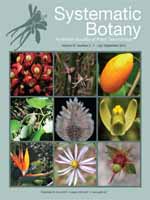The Metastelmatinae (Asclepiadoideae, Apocynaceae) include 13 genera and approximately 260 species with complex morphological affinities that are broadly distributed in the Neotropics. This study investigated phylogenetic relationships within this subtribe using plastid (trnT-F, trnS-G, trnH-psbA, trnD-T, rps16, and matK) and nuclear (ITS) markers. The taxonomic sampling focused on the South American species, and included approximately 25% of the subtribe. Individual data partitions, and combined datasets were analyzed using Bayesian inference, maximum likelihood, and maximum parsimony. The results indicated that most genera of Metastelmatinae are not monophyletic. Internal relationships in the subtribe and key morphological characters used in the taxonomy of the group are discussed. The lack of resolution in the molecular phylogeny, incongruent phylogenetic signals between plastid and nuclear datasets, and the lack of morphological features for individual clades prevented major taxonomic changes in this group, those of which were restricted to the inclusion of Barjonia harleyi and Hemipogon harleyi into Minaria forming the new combinations Minaria harleyi and M. volubilis, and the synonymy of Macroditassa under Peplonia with the new combinations Peplonia adnata and P. macrophylla.
How to translate text using browser tools
1 September 2012
Taxonomic Considerations on Metastelmatinae (Apocynaceae) Based on Plastid and Nuclear DNA
Uiara Catharina Soares e Silva,
Alessandro Rapini,
Sigrid Liede-Schumann,
Patrícia Luz Ribeiro,
Cássio van den Berg
ACCESS THE FULL ARTICLE

Systematic Botany
Vol. 37 • No. 3
July 2012
Vol. 37 • No. 3
July 2012
Asclepiadaceae
Asclepiadoideae
incongruent data
phylogenetics
systematics
taxonomy




